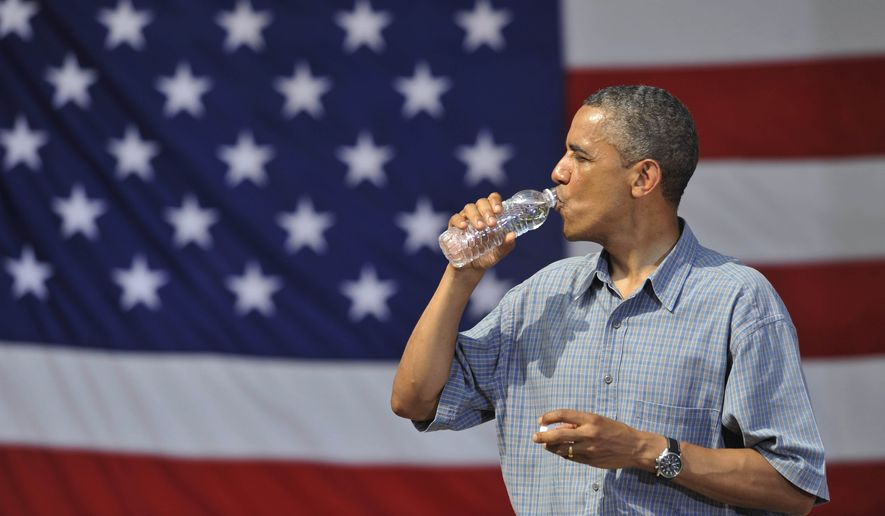Fracking does not pose a direct threat to drinking water supplies, the Obama administration said Thursday in a major study that represents a serious blow to environmentalists and other vocal opponents of U.S. oil and gas production.
The landmark Environmental Protection Agency report, nearly five years in the making, found that the drilling technique had no “widespread, systemic impacts on drinking water.” The conclusion casts doubt on the wisdom of President Obama’s latest regulations for governing fracking on public lands and undermines the claims of environmentalists, many Democrats, some liberal media outlets and others who have led the charge against fracking.
The EPA study did identify several “potential vulnerabilities” in the fracking process and found several instances in which spills at drilling sites found their way into water supplies.
Those isolated incidents do not indicate that fracking itself carries inherent risks to water, the EPA said.
“EPA’s draft assessment will give state regulators, tribes and local communities and industry around the country a critical resource to identify how best to protect public health and their drinking water resources,” said Thomas A. Burke, the EPA’s science adviser and deputy assistant administrator of the agency’s office of research and development.
Specifically, the report identified “mechanisms” by which fracking — short for hydraulic fracturing — can contaminate water supplies. Those mechanisms include spills, inadequate treatment and discharge of wastewater. Nothing in the EPA’s report, however, backs up environmentalists’ claim that fracking is a direct threat to drinking water.
PHOTOS: Bang for your buck: Best handguns under $500
“We did not find evidence that these mechanisms have led to widespread, systemic impacts on drinking water resources in the United States,” the study says.
Fracking involves injecting millions of gallons of water mixed with chemicals into rock formations at high pressure, breaking apart the rock and releasing trapped fuel.
The process has dramatically transformed the U.S. energy landscape and has helped push domestic production of oil and natural gas to near-record highs. Thanks to widespread use of fracking in Pennsylvania, North Dakota, Texas and elsewhere, the U.S. is now the world’s No. 1 producer of oil and natural gas, and imports are at historic lows.
But the rise of fracking also spawned an intense backlash. Amid public protests, New York banned the process. Maryland has a moratorium on fracking.
Many of the concerns about fracking’s impact on drinking water come from the 2010 documentary “Gasland,” which perpetuated the notion that the practice dramatically raises methane levels and otherwise contaminates drinking water.
Many leading media outlets, including The New York Times, also have come under fire from conservatives who say they are pushing an anti-fracking narrative that isn’t backed up by science.
PHOTOS: Best handguns ever made
After the landmark EPA study began making headlines, environmentalists blasted the report’s methodology and said the administration failed to dig deeply enough.
“The EPA chose to leave many critical questions unanswered. For example, the study did not look at this issue under the lens of public health and ignored numerous threats that fracking poses to drinking water. The EPA must conduct a comprehensive study that results in action to protect public health,” said Michael Brune, executive director of the Sierra Club, one of the nation’s leading environmental activism groups.
Oil and gas industry leaders say critics such as Mr. Brune no longer have standing in light of the EPA report.
“Hydraulic fracturing has brought cleaner air, significantly reduced greenhouse gas emissions, created millions of jobs, reduced energy prices, strengthened national security, and turned the American economy around,” said Katie Brown, a researcher with Energy in Depth, a project of the Independent Petroleum Association of America. “With this new report, it couldn’t be clearer that shale development is occurring in conjunction with environmental protection — and the claims by anti-fracking activists have been thoroughly debunked.”
Several lawmakers say the findings highlight the foolishness of the administration’s latest regulations controlling fracking on federal lands. The rules, released by the Interior Department in March, specifically call for enhanced measured to protect drinking water supplies, such as requiring stronger boreholes to stop any leakage.
“After five years of study, the EPA learned exactly what the states, industry and even some of the more competent bureaucrats in the Obama administration have known for some time — hydraulic fracturing is not a threat to drinking water. This report is damaging for the administration and contradicts a predominant claim the White House has used to justify a federal fracturing rule,” said Rep. Rob Bishop, Utah Republican and chairman of the House Natural Resources Committee.
In the report, the EPA said it studied 225 spills at fracking sites. Of those, only 8 percent saw fracking water reach surface or ground water, the agency said.
The incidents cited in the EPA study include a well blowout in Bradford County, Pennsylvania, where an estimated 10,000 gallons of fracking water reached a state-designated trout fishery.
Despite the lengthy report, the agency candidly said it needs more data.
“There is insufficient pre- and post-hydraulic fracturing data on the quality of drinking water resources,” the study says in its conclusion.
• Ben Wolfgang can be reached at bwolfgang@washingtontimes.com.




Please read our comment policy before commenting.